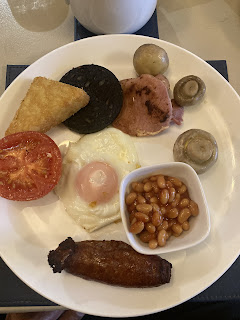Traditional English Breakfast
The full English breakfast, a veritable national institution, consists of fried eggs, sausages, back bacon, tomatoes, mushrooms, fried bread and often a slice of white or black pudding (oats and pig blood).
It is accompanied by tea or coffee and hot, buttered toast. These days, it may also include other items such as baked beans and hash browns.
The tradition of breakfast dates back to the Middle Ages, when there were usually only two meals a day; breakfast and dinner. Breakfast was served mid or late morning, and usually consisted of just ale and bread, with perhaps some cheese, cold meat or dripping.
The tradition of breakfast dates back to the Middle Ages, when there were usually only two meals a day; breakfast and dinner. Breakfast was served mid or late morning, and usually consisted of just ale and bread, with perhaps some cheese, cold meat or dripping.
By Georgian and Victorian times, breakfast had become an important part of a shooting party, weekend house party or hunt and was served a little earlier. The gentry loved to entertain lavishly and that included breakfast.
Breakfasts were unhurried, leisurely affairs with plenty of silver and glassware on show to impress the host’s guests. The breakfast table would groan under the weight of the produce from the host’s estate.
Newspapers were available for the family and guests to catch up on the day’s news. Indeed, it is still socially acceptable today to read newspapers at the breakfast table (a definite ‘no-no’ at any other meal).
The Victorian era saw a wealthy middle class begin to emerge in British society who wished to copy the customs of the gentry, including the tradition of the full English breakfast. As the middle classes went out to work, breakfast began to be served earlier, typically before 9am.
Surprisingly, the full English breakfast was also enjoyed by many of the working classes. The punishing physical labour and long hours of work in the factories of the Industrial Revolution meant a hearty meal first thing in the morning was necessary. Even as late as the 1950s, almost half the adult population began their day with a good old English fry-up.




I love this food anthropology! So interesting! I love the idea of ale and bread too, and will be sure not to read a paper at other meals. The hidden story is why the Victorian era saw a wealthy middle class to emerge. Thank you! Mary Jane
ReplyDelete